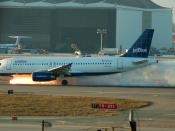JetBlue just like all other start up companies' faces challenges as they seek to find their place, establish a market presence, and develop processes and procedures. Imagine dealing with the problems and issues of a start-up company while coordinating a staff of 2500 plus employees, adding about 5-6 new employees a day while competing in one of the toughest industries in the world. JetBlue has chosen to implement and continues to use in their transformation of the organization a change base Culture Model and Kurt Lewin's three- phrase model for change.
The low-cost airline entered the market in 2000. JetBlue survived competition from major airlines, the travel turmoil following the terrorist attacks of September 11, 2001 and the uncertainty tied to any start-up company. JetBlue sought to re-define air travel by bringing humanity back to it. JetBlue has made a mark on the airline industry through its aggressive and unconventional approach which mirrored the leadership style of its founder and CEO, David Neeleman.
Neeleman created the vision for JetBlue Airways after experience starting another airline and working at Southwest Airlines. He jumped into his newest venture, with the support of David (Dave) Barger, president of JetBlue. David and Dave, as they are known, provide a vision and leadership that continue to cascade through-out the organization. They created a company that saw profits when other airlines were failing. They made over $1.2 billion in revenue in 2004 (Kochan, 2006). By the end of 2005 JetBlue was the first airline to implement paperless cockpit flight technology and have 100% e-tickets.
The System Operations Center (SOC) is the heart of the airline - the epicenter where effective decision-making, communication, teamwork, and leadership are critical to ensure that crewmembers (JetBlue vernacular for employees) are able to meet and exceed customer needs. This department has...


